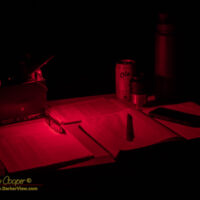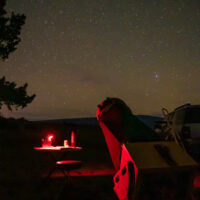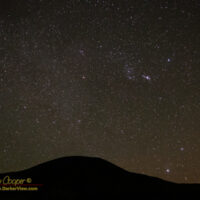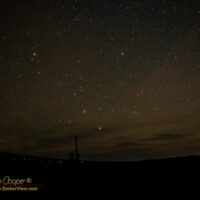A dark moon weekend? I had not been out in a while, time for some dark skies with a telescope. This night had been scheduled for a while, the folks I work with keep asking me about getting a look through one of my big ‘scopes. Thus this night had been set aside on a calendar normally used for staff meetings and investor conference calls.
Where? Kaʻohe of course, the best place for this on the west side, easy range for my friends coming up from Kona.
Everone arrived on schedule at sunset, car pooling up from Kona. Greeted by a spectacular sky, a slim crescent Moon seeting into the golden glow of Hualalai, the bright planets Venus and Jupiter appearing in the gloaming.
The first part of the night was spent in astro-tour mode. Considering the gasps and various exclamations I heard from whomever was looking in the eyepice I suspect everyone was suitably impressed. An 18″ under a dark sky? Planets and a nice set of Milky Way targets available? Yup.
We hit all the major showpiece targets available and at least one good example of each of the major types of objects. Nebula? Check. Globular cluster? M22 should do. Galaxy? Andomeda just came over the treetops and was spectacular. M57 will serve for a planetary nebula. The Double Cluster open clusters were simply spectacular. While M1 was still behind the trees The Veil can provide a nice example of a supernova remnant.
The night was also notable for good meteor activity. With the peak of the southern Taurids occuring in early November this is no surprise. Sure enough, most of the brighter meteors we saw had a path consitent with a radiant near Taurus.
Around 9pm everyone else headed home leaving alone with the telescope and the sky. Time to do some observing for myself, I started with some objects in Cygnus including all of the various parts of The Veil Nebula.
More than once I would look up at the sky and note to myself how bright the sky seemed. This was particularly true near the horizon in directions it should have been dark. I could blame the glow behind Hualālai on the lights of Kona, perhaps some glow from Kilauea over the eastern flank of Mauna Loa? Between Hualālai and Mauna Loa it should just be dark, but even there the glow was notable.
Knowing that there had been a lot of geomagnetic activity lately I suspected enhanced airglow. This is easy to check, just take a few photos, I have a camera and a fast lens with me. And sure enough, all across the southern sky is a red glow with some structure visible in the photos, some high altitude cirrus is sihouetted against the glow. A notable red streamer extending northwards over Hualālai.
About half past midnight I turned to my primary target of the night, the Fornax Cluster of galaxies. I had hoped to work my way into a printout of 56 galaxies between 3h and 4h in RA and -30° to -40° declination. This plan was not going to happen.
I spotted the first galaxy quickly enough, NGC 1316 or Fornax A is large and bright, with a small companion on the northern margin. It is when I found NGC1310 that I realized conditions were a becoming problem. This was a 12th magnitude galaxy, pretty bright for an 18″ ‘scope, but it looked as it would through an 8″ telescope, visible, but just barely. Something is not right here.
The cirrus was getting worse, combined with the skyglow this was hampering my visibility rather dramatically. Taking a look at the satellite it was apparent that it was just going to get worse, thicker cirrus appraoching from the southwest. I packed it in and headed home.
Still, a nice night. Fun to share the beauty of the sky with the folks I work with. And fun to enjoy views of some old favorites.





